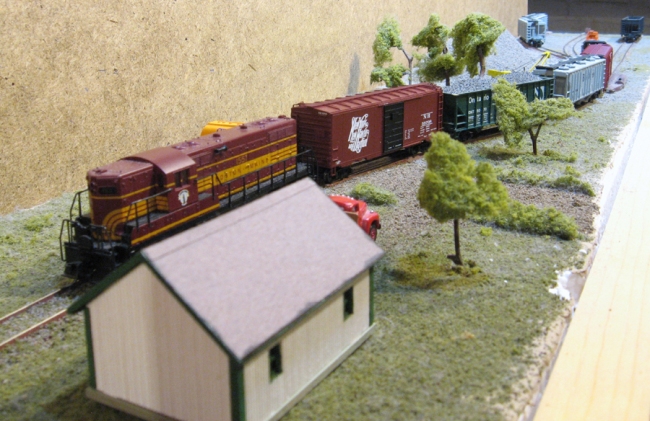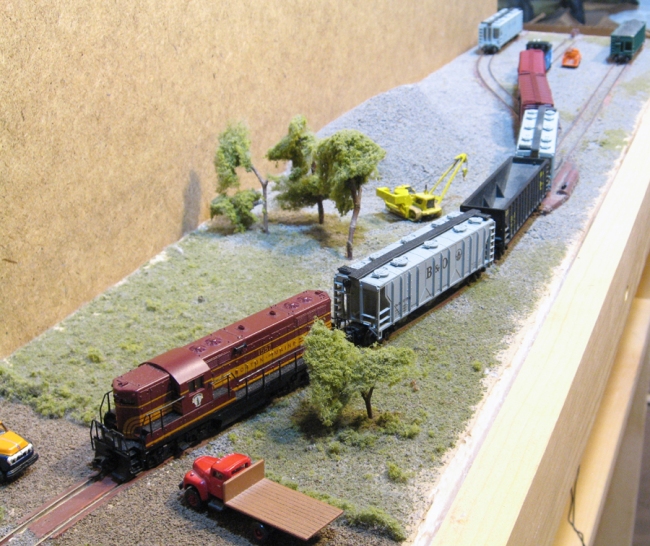Operations Department
A Day In The Life Of The Grafton Quarry Branch: Simple But Fun Operations –
I discussed the reactivation of the Grafton Quarry Branch in my last post. In this post I will cover a normal operating session and, hopefully, illustrate that interesting operations can be had on even a limited micro-layout.
I envision most of the stone product going to use in major construction projects in the more heavily populated southern part of New Hampshire, so the train represents a local based out of Concord.
On the Grafton Quarry Branch an operating session begins with a back up move, there aren’t any sidings so a run-around is out of the question. With the train assembled the engineer begins his move, south bound, towards the quarry yard (as I mentioned in my earlier post the train for the next operating day is built on the layout it’s self since there is no staging). The grade crossing seen above remains blocked between sessions which is no doubt a major cause of concern among the locals.
Today’s Inbound Train: GP7 #1557 – 40ft boxcar, 90t open aggregate hopper, covered cement hopper, 40ft boxcar, caboose.
The shipper requested an open hopper be spotted on the aggregate loading track (right in the above photo) and the covered hopper spotted on the cement loading track (left in the above photo). In kind the train must retrieve the two loaded covered hoppers and the loaded open hopper, placing them 1, 3, and 2 in the outbound manifest in front of the two 40ft boxcars so they can be switched off-layout.
The cement loading track only holds two cars, although it is possible to place three there if you don’t need to use the switch. The storage track (center) also only holds 2 cars without interfering with the switch. The aggregate loading track holds three cars, four if you are desperate and slight car to car collisions don’t upset your ulcer too much. Four cars and a caboose will just clear the first switch when pulled onto the yard lead. This gives you relatively limited space to do switching and can make an operating session fairly challenging if the too many cars are involved (the most I have ever had on layout at one time was seven freight cars, a caboose, and an S4 locomotive. The layout was cramped and a many additional moves were required to assemble the outbound train). I assign inbound spots in the yard by type, not by car number.
Example: D/O
1 Cement Hopper to Load
1 Cement Hopper to Storage
1 Aggregate to Load
(Here I have placed the three inbound empties on separate tracks because the shipper is receiving two cement hoppers but only has an order for one carload of cement.)
Or: D/O
1 Cement Hopper to Load
1 Cement Hopper from Storage to Load
1 Aggregate Hopper to Load
(Here the empty formerly left on the storage track is to be spotted on the load track to fulfill an increased order.)
I find disposing of the caboose and the rear most car, not intended for the quarry, on the storage track is the best first move. Next, I generally try to get the aggregate cars switched and in correct order for the outbound train, followed by the cement hoppers, and then arranging any extra cars in the consist.
When I write the train order for the following operating day I assign each load a number representing its position in the outbound train. Sometimes I split them up and sometimes I group like cars. Boxcars and other cars in the train not loaded at the quarry take up the remaining positions and I typically don’t pay too much attention to what order they are in.
Example: P/U
2 Cement Hoppers 1,4
1 Aggregate Hopper 2
(Here the cement hoppers are 1 and 4 in the consist and the aggregate hopper is 2. That means the first two spots in the outbound manifest are occupied so spot 3 and 5 could go to boxcars or other cars unrelated to the quarry.)
Or: P/U
2 Cement Hoppers 1,2
1 Aggregate Hopper 5
(Here the cement hoppers occupy spots 1 and 3, then the unrelated cars would be placed in spots 3 and 4, with the aggregate hopper bringing up the rear along with the caboose.)
When the outbound train departs, and terminates at the northern edge of the layout, I disassemble the train and switch out my unrelated cars with cars of different types or lengths… to keep things visually interesting and operationally challenging. The next day’s inbound empties for the quarry are placed back into the consist randomly, this ensures that switching the quarry is never just a matter of reversing the previous day’s operations.
Once the inbound train is assembled for the next day there is nothing to do but rearrange the vehicles at the crossing and admire your work. If I have had a particular good (read: challenging) operating session, I will reminisce about it and decide, with absolute certainty, that I will never be able to top that performance. Sometimes I get through a session with no wasted moves. More often than not, I get ready to spot a car only to discover that it won’t fit through the switch, or that I have been moving a load which I thought was an empty… back it goes and the N scale boss gets to drink a little more pink-bismuth to sooth his stress-related stomach issues.
I hope you enjoyed this overview of operations on my little branch. I would like to think that it will give people the kick in the pants they need to get started in the hobby but, frankly, I don’t operate very realistically so rivet counters might call for my head on a platter if people got into model railroading using my practices.
As an aside: Yes there is a side-boom dozer in the yard and yes, there are that many derailments (it was easier to have the dozer on-hand than to teach safety to my train crews). What can I say, three full-scale children can be distracting when you are making backup moves… sue me.



Recent Comments